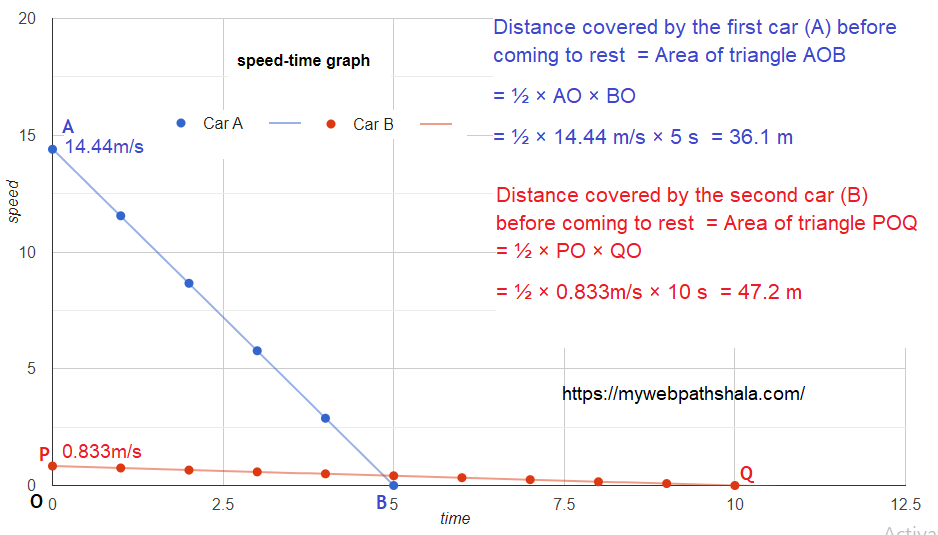A driver of a car travelling at 52 km/ h applies the brakes and accelerates uniformly in the opposite direction. The car stops in 5 s. Another driver going at 3 km/ h in another car applies his brakes slowly and stops in 10 s. On the same graph paper, plot the speed versus time graphs for the two cars. Which of the two cars travelled farther after the brakes were applied?
ANSWER:
For car A:
Initial speed of the car (A) = 52 km/h × 5/18 = 14.4 m/s
From equation of motion 1st v = u + at
a = (v-u) / t = (0 – 14.44 ) / 5 = -2.89 m s–2
Putting these value in equation of motion 1st v = u + at
t =0 v = u + at = 14.4 + (-2.89) × 0 = 14.4 m/s
t =1 v = u + at = 14.4 + (-2.89) × 1 = 11.55 m/s
t =2 v = u + at = 14.4 + (-2.89) × 2 = 8.66 m/s
t =3 v = u + at = 14.4 + (-2.89) × 3 = 5.77 m/s
t =4 v = u + at = 14.4 + (-2.89) × 4 = 2.88 m/s
t =5 v = u + at = 14.4 + (-2.89) × 5 = 0 m/s
Using these value plot graph between speed-time for car B.
From graph: Distance covered by the first car (A) before coming to rest = Area of triangle AOB = ½ × AO × BO = ½ × 14.44 m/s × 5 s = 36.1 m

For car B:
Initial speed of the car (A) = 3 km/h × 5/18 = 0.833 m/s
From equation of motion 1st v = u + at
a = (v-u) / t = (0 – 0.833 ) / 10 = – 0.083 m s–2
Putting these value in equation of motion 1st v = u + at
t =0 v = u + at = 0.833 + (-0.083) × 0 = 0.833 m/s
t =1 v = u + at = 0.833 + (-0.083) × 1 = 0.75 m/s
t =2 v = u + at = 0.833 + (-0.083) × 2 = 0.66 m/s
t =3 v = u + at = 0.833 + (-0.083) × 3 = 0.58 m/s
t =4 v = u + at = 0.833 + (-0.083) × 4 = 0.50 m/s
t =5 v = u + at = 0.833 + (-0.083) × 5 = 0.416 m/s
t =6 v = u + at = 0.833 + (-0.083) × 6 = 0.333 m/s
t =7 v = u + at = 0.833 + (-0.083) × 7 = 0.250 m/s
t =8 v = u + at = 0.833 + (-0.083) × 8 = 0.160 m/s
t =9 v = u + at = 0.833 + (-0.083) × 9 = 0.083 m/s
t =10 v = u + at = 0.833 + (-0.083) × 10 = 0 m/s
Using these value plot graph between speed-time for car B.
From graph: Distance covered by the second car (B) before coming to rest = Area of triangle POQ = ½ × PO × QO = ½ × 0.833m/s × 10 s = 47.2 m
Thus, the second car (B) travels farther than the first car (A) after they applied the brakes.

Table of Contents
Click here 🖱️👉 Motion Class 9 Quiz-1
Click here 🖱️👉 Motion Graphs Class 9 Quiz-2
Click here 🖱️👉 Motion NCERT Questions Solution
Click here 🖱️👉 Motion NCERT in-text Questions Solution
Click here 🖱️👉 Motion – additional practice Questions
Force and Laws of Motion QUIZ-1 🖱️👉 START QUIZ
Other NCERT exercise questions
👉🖱️ UP Special GK ↗
उत्तर प्रदेश के बारे में संक्षिप्त और सारगर्भित जानकारी के लिए ऊपर दिए गए लिंक पर क्लिक कीजिए।
👉🖱️ भारतीय इतिहास ↗
भारतीय इतिहास को तथ्यात्मक दृष्टि से पढ़ने के लिए ऊपर दिए गए लिंक पर क्लिक कीजिए।
👉🖱️ Physics Class 12↗
Click on the above link for detailed study of class 12th Physics.
A driver of a car travelling at 52 km/ h applies , A driver of a car travelling at 52 km/ h applies , A driver of a car travelling at 52 km/ h applies , A driver of a car travelling at 52 km/ h applies , A driver of a car travelling at 52 km/ h applies , A driver of a car travelling at 52 km/ h applies , A driver of a car travelling at 52 km/ h applies
A driver of a car travelling at 52 km/ h applies , A driver of a car travelling at 52 km/ h applies , A driver of a car travelling at 52 km/ h applies , A driver of a car travelling at 52 km/ h applies , A driver of a car travelling at 52 km/ h applies , A driver of a car travelling at 52 km/ h applies , A driver of a car travelling at 52 km/ h applies , A driver of a car travelling at 52 km/ h applies